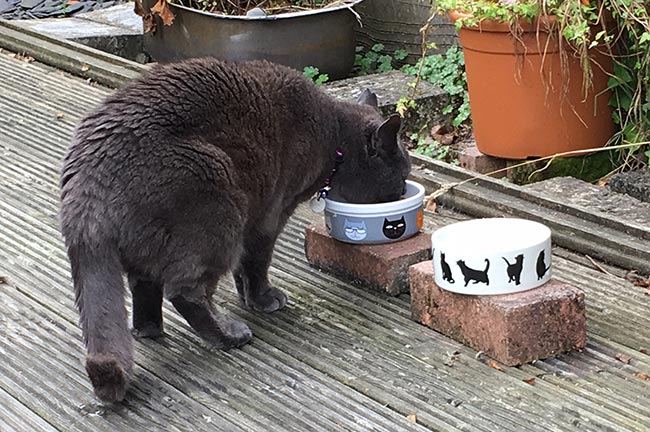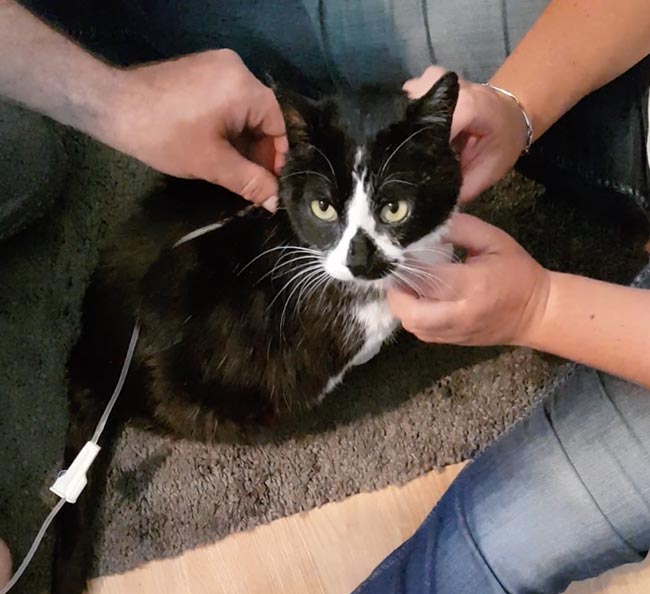3 May 2022
Sarah Caney notes research updates on this condition, and explains how professionals can support pets and pet owners.

Image © iVazoUSky / AdobeStock
Chronic kidney disease (CKD) is one of the most common diagnoses made in clinical practice, thought to affect at least a third of elderly cats (Sparkes et al, 2016).
Criteria for diagnosis of this condition include presence of azotaemia and/or elevated symmetric dimethylarginine (SDMA) in addition to a reduced urine specific gravity (USG; less than 1.035) in a cat with compatible clinical signs.
CKD is a chronic progressive condition and, although now considered manageable, ultimately it is an incurable condition.
The rate of progression varies from case to case and is not readily predictable, although markers of progression, such as proteinuria, hyperphosphataemia and anaemia, can be of some value.
While most clinical cases are diagnosed following presentation when unwell, many clinics now offer screening tests to apparently healthy, “at risk” (older) cats attending.
A recent large scale survey of UK-based cat owners indicated that 11% of cats with CKD were diagnosed as a result of wellness screening (Caney, 2017).
Kidneys perform many complex functions essential for the maintenance of homeostasis and excretion of waste products. Optimal management of CKD typically includes transition to a therapeutic renal diet (TRD) with additional medications according to the patient’s needs (Figure 1).

Investigations such as blood pressure assessment and renal ultrasound may be recommended in addition to regular check-ups.
Happily, the prognosis for cats with CKD has improved markedly over the past several decades, and many cats with this condition can be expected to live for several years with a good quality of life.
Receiving a diagnosis of CKD can be difficult and shocking for our clients, not least as many know from the start that this is an incurable condition. Successful management can be emotionally, practically and financially draining for carers. Client communication at this point is essential in providing support and reassurance. Ultimately, the management plan should be designed to suit not only the cat’s needs, but the carer’s expectations, ambitions and abilities.
Compliance to recommendations for investigations or treatment depends not only on concordance with the client, but also patient compliance. Commonly encountered factors impacting compliance include lack of understanding, and practical and financial concerns.
CKD is a chronic health condition with additional factors likely impacting compliance, including:
The author’s approach to optimising compliance starts with a detailed assessment of the patient and understanding of the client expectations, such that an individually focused, holistic plan can be formulated with the involvement of the carer, to whatever degree they wish to be involved.
A key feature of the plan is that it can be amended at any point, it is not “set in stone” and, therefore, the carer is empowered to voice concerns at any point. Regular contact with the carer, which may be via email/phone rather than formal face-to-face appointments, facilitates further discussion, support and adjustment of the plan. The carer should feel a full member of their cat’s “care team” and, indeed, their input is pivotal to successful management.
Clients often appreciate support of recommendations via printed materials (such as books, leaflets), advice on websites to visit and/or apps to download. The author’s website (Caney, 2022) has a large number of free-to-access resources in the “helpful info” section aimed at carers of cats with CKD, in addition to a book, Caring for a Cat with Chronic Kidney Disease.
Carers who receive a recommendation to feed a therapeutic renal diet from their veterinarian are more likely to offer this to their cat (Caney, 2017), and further support from their veterinary clinic will only strengthen this recommendation.
Offering a range of management styles from “intense and expensive” to “hands off and cheap” may be beneficial, as indicated from data relating to veterinarians’ experience of managing diabetic cats and dogs (Niessen et al, 2017).
A relationship-centric approach to client discussions has also been reported to be associated with greater adherence to recommendations relating to treatment of small animals (Kanji et al, 2012) and, therefore, may be an advantage with CKD cats also.
Flexibility regarding necessity for face-to-face appointments, and support of those cats and owners that find a visit to a vet clinic stressful, is recommended. Many committed carers can be “trained” to provide high-quality clinical data from their cat at home that can be used to guide treatment decisions. This can include the purchase of scales to facilitate home weight checks, and recording the cat’s behaviour, appetite and toileting in a diary, which can be shared electronically.
With appropriate training and support, carers administering SC fluids to support a cat’s hydration often become adept at assessing hydration and judging its ongoing fluid requirements (Cooley et al, 2018; Figure 2).

For situations where a visit to a vet clinic is essential, strategies aimed at reducing stress in the cat and carer should be followed. Owner-observed stress associated with a visit to a vet clinic is known to deter clients from making future in-clinic appointments for their cats (Habacher et al, 2010). Especially anxious cats may benefit from pre-visit gabapentin (van Haaften et al, 2017), an appointment at a quieter time of the day, and calm and empathetic handling.
Support for medicating cats, where needed, is important. Although compliance to medication is a poorly studied area of veterinary science, one study showed that a quarter of cat owners were unable to give some doses of medication prescribed, with owners reporting challenges including cats refusing medication in food, spitting out the medication or hyper-salivating (Siven et al, 2017).
Owners should be shown how to administer medication and invited to seek whatever further support they need for their cat.
Where available, owners should be advised on formulation choices that exist: some owners report administering a liquid medication to be easier than a tablet, for example (Siven et al, 2017).
Successful transition to a TRD typically takes time and hard work from the carer’s perspective.
Cats are renowned for their discerning nature, and may be reluctant to change to a new food that looks, smells, tastes and feels different to them – especially if their appetite is already suppressed due to their CKD.
Long-term acceptance is enhanced by a gradual transition period. Transitioning to a TRD should only be done when the patient is clinically well and ideally not in the vet hospital. All measures should be taken to address issues that may affect appetite; for example, complications such as hypokalaemia, nausea, dehydration, anaemia, pyrexia, pain and metabolic acidosis should be corrected before attempting to transition to a new food.
If appetite is poor, appetite stimulants such as mirtazapine (for example, 1mg to 2mg every 48 hours) can be considered.
Transitioning can be helped if the “new” diet is similar in formulation to the cat’s current diet, as this is more likely to encourage acceptance; for example, a change from Hill’s Science Plan to Hill’s k/d is likely to be more straightforward than a change from a supermarket commercial cat food to a therapeutic diet.
It is always more important that the cat eats some food than no food, so carers should expect some day-to-day variation in acceptance of the new food and be prepared to “go backwards” in terms of what they offer their cat (that is, back-off the new food and offer more of the cat’s previous diet). The transition should be viewed as a long-term goal, which may take months to achieve in their cat.
Where possible, cats with CKD should be offered a wet food to assist with hydration control. An increasing number of commercially available TRDs are now available in “soup” or “stew” formulations, and may also help to encourage fluid intake.
“Dry food addicts” can be encouraged to eat wet food by sprinkling their dry food on top of the wet and/or mixing into the wet food. A dry TRD is superior to alternative dry foods in cats with CKD, so the current dry food should be transitioned to a dry therapeutic renal diet. Grinding the dry food up and mixing it with the new wet food may help.
Throughout the transition period, weight and general progress should be monitored to ensure success is being critically assessed, and helped, as needed.
Encouraging water intake is an important recommendation in cats with CKD since dehydration (acute on chronic CKD) is common and has a deleterious impact on patient status. Dehydration may contribute to progression of CKD through reduced renal blood flow and associated tissue hypoxia.
Water bowl type and positioning can affect voluntary water intake. Most cats prefer glass, ceramic or stainless-steel bowls rather than plastic, which may taint the taste of the water. Experimenting with different bowl shapes and sizes can also be helpful: most cats prefer wide, shallow bowls, but some like drinking out of a tall glass, jug or even a mug.
Water bowls should be available in all areas of the home that the cat spends time in, and for multi-cat households, there should be at least one water bowl per social group plus one extra. Water bowls should not be next to a food bowl, litter tray or in a busy or overlooked location. Cats with concurrent osteoarthritis affecting their cervical spine or forelimbs may also appreciate access to raised bowls. Moving water sources such as dripping taps or water fountains are popular with some cats and may encourage drinking in some individuals. The type of water offered can also affect water intake: cats may prefer tap water, collected rainwater or mineral water.
Most cats like water to be at room temperature, although some can have different preferences. Flavoured waters can also encourage drinking.
Recently, Purina launched a complementary nutritional supplement (HC HydraCare) which has been shown to increase water intake (Zanghi et al, 2018).
While low in calories, it is very palatable: cats offered a choice of tap water and HC HydraCare preferentially consumed more of the HC Hydracare in one study (Zanghi et al, 2018) and, therefore, it may be of value in maintaining hydration in cats with CKD.
In conclusion, management of cats with CKD can be very rewarding for cat, carer and clinician. Working as a team with a holistic, individualised approach to patient care is typically associated with an excellent outcome.